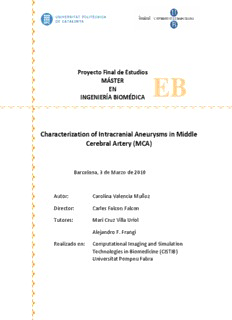
Characterization of Intracranial Aneurysms in Middle Cerebral Artery PDF
Preview Characterization of Intracranial Aneurysms in Middle Cerebral Artery
Proyecto Final de Estudios EB MÁSTER EN INGENIERÍA BIOMÉDICA Characterization of Intracranial Aneurysms in Middle Cerebral Artery (MCA) Barcelona, 3 de Marzo de 2010 Autor: Carolina Valencia Muñoz Director: Carles Falcon Falcon Tutores: Mari Cruz Villa Uriol Alejandro F. Frangi Realizado en: Computational Imaging and Simulation Technologies in Biomedicine (CISTIB) Universitat Pompeu Fabra Resumen Los aneurismas intracraneales han sido el objetivo de muchos investigadores, pero a pesar de haber encontrado múltiples correlaciones entre la ruptura del aneurisma y los factores de riesgo, su estudio sigue siendo limitado. Ya que la morfología de aneurismas cerebrales ha sido considerada como un potencial suplente de ruptura, en este proyecto la influencia de variables morfológicas en la ruptura del aneurisma ha sido estudiada. Entre las características morfológicas propuestas, diversos índices han permitido establecer vínculos con el riesgo de ruptura para una lesión específica. Estos podrían conducir a una mejor comprensión de los mecanismos de ruptura de aneurisma cerebral. Este estudio se presenta una completa y eficiente metodología basada en imágenes para el análisis de aneurismas cerebrales específicos del paciente, incluyendo el saco y las arterias adyacentes. Esta metodología permite al modelado de un número elevado de aneurismas de una manera eficiente para obtener un modelo específico de la geometría del aneurisma del paciente. La metodología emplea algoritmos que iniciando desde las imágenes de Angiografía Rotatoria Tridimensional (3DRA), creando un modelo de malla que morfológicamente es procesado produciendo un número de medidas básicas de forma así como medidas más sofisticadas como los Momentos de Zernike. Estos cómputos han sido realizados sobre una población de 95 aneurismas rotos y no rotos (79 pacientes) localizados en la Arteria Cerebral Media (MCA). Entre el conjunto de índices calculados, estudios estadísticos muestran que entre más información tridimensional los descriptores morfológicos contienen, más robusto discriminan entre aneurismas rotos y no rotos. Éste es el caso para los Momentos de Zernike basados en el volumen, que proporcionaron los mejores resultados de predicción en comparación con otros descriptores como el índice de no esfericidad. 1 Abstract Intracranial aneurysms have been the aim of many researchers, but despite finding multiple correlations between aneurysm rupture and risk factors, their study still remains limited. Since cerebral aneurysms morphology has been considered as a potential surrogate of rupture, in this project the influence of morphological variables in the aneurysm's rupture have been studied. Among the proposed morphological characteristics, several indices have allowed to establish links between these descriptors and the risk of rupture for a specific lesion. These might lead to a better understanding of the cerebral aneurysm rupture mechanisms. This study presents a complete and efficient image-based methodology for the analysis of cerebral aneurysms on a patient-specific basis including the sac and the parent vessel. This methodology allows the modeling of a large number of aneurysms in a time-efficient manner to obtain a patient- specific model of the aneurysm geometry. Our pipeline uses algorithms that starting from Three- Dimensional Rotational Angiography (3DRA) images create a mesh model that is morphologically processed producing a number of basic shape measurements as well as most sophisticated ones such as the Zernike Moments. These computations have been performed on a population of 95 ruptured and unruptured aneurysms (79 patients) located at the Middle Cerebral Artery (MCA). Among the set of computed indices, statistical studies show that the more tridimensional information the morphological descriptors contain, the more robust they are discriminating between ruptured and unruptured aneurysms. This is the case for volume-based Zernike moments, which provided the best prediction results compared to other descriptors such as the Non-Sphericity Index. 3 Table of Contents Resumen ...................................................................................................................................................1 Abstract ....................................................................................................................................................3 Table of Contents .....................................................................................................................................5 Abbreviations ...........................................................................................................................................7 Introduction .............................................................................................................................................9 Chapter I Background and Objectives ................................................................................................... 11 I.1. Cerebral vasculature ....................................................................................................................... 11 I.1.1. Circle of Willis ...................................................................................................................... 12 I.2. Cerebral Aneurysms ........................................................................................................................ 13 I.2.1. Classification and Risk Factors ............................................................................................. 13 I.2.2. Symptoms and Diagnosis .................................................................................................... 16 I.2.3. Treatment and therapies .................................................................................................... 16 I.3. Imaging techniques ......................................................................................................................... 18 I.3.1. Computed Tomography Angiography (CTA) ....................................................................... 18 I.3.2. Magnetic Resonance Angiography (MRA)........................................................................... 18 I.3.3. Three-Dimensional Rotational Angiography (3DRA) ........................................................... 18 I.4. Image-based Modeling .................................................................................................................... 20 I.5. Morphological Characterization: Literature Overview ................................................................... 22 I.6. Objectives ........................................................................................................................................ 29 Chapter II Materials and Methods ........................................................................................................ 30 II.1. Patient Population .......................................................................................................................... 30 5 6 Characterization of Intracranial Aneurysms in Middle Cerebral Artery (MCA) II.2. Reconstructed Models .................................................................................................................... 30 II.2.1. Image Data .......................................................................................................................... 31 II.2.2. Image segmentation ........................................................................................................... 31 II.2.3. Surface meshing ................................................................................................................. 32 II.2.4. Skeleton .............................................................................................................................. 32 II.2.5. Isolation of the model ........................................................................................................ 32 II.3. Morphological Characterization ..................................................................................................... 33 II.3.1. Size indices .......................................................................................................................... 33 II.3.2. Shape indices ...................................................................................................................... 33 II.4. Statistical analysis ........................................................................................................................... 35 II.4.1. Linear Discriminant Analysis (LDA) ..................................................................................... 36 II.4.2. Principal Components Analysis (PCA) ................................................................................. 37 II.4.3. Receiver Operating Curves (ROC) ....................................................................................... 37 Chapter III Results .................................................................................................................................. 38 Chapter IV Discussion and Limitations .................................................................................................. 43 Chapter V Conclusions and Further work .............................................................................................. 45 Acknowledgements ............................................................................................................................... 47 List of figures ......................................................................................................................................... 48 List of tables ........................................................................................................................................... 49 Bibliography ........................................................................................................................................... 50
Description: